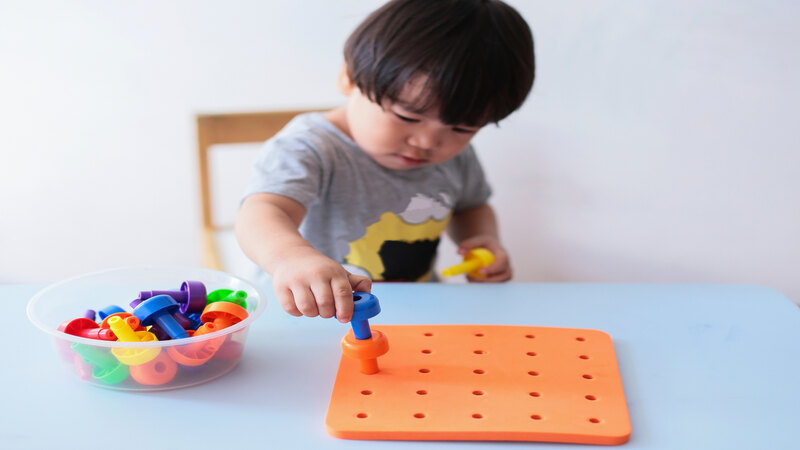
Toddlers are active and full of energy and curiosity. These days are marked by growth and development. During this time, toddlers’ motor skills develop rapidly. They spend time adapting to the changing environment, perceiving information, and indulging in activities involving touch and sight, often referred to as fine motor skills development.
Fine motor skills development in toddlers improves with age between 12 to 24 months. As they grow, their attention span improves and they can concentrate on completing tasks while coping with challenges. To learn more about fine motor skills, development milestones, and conditions to take care of, keep reading the article.
What Are Fine Motor Skills?

Fine motor skills involve moving small muscles in the hands and wrists. These skills include grasping, reaching, and manipulating objects with hands. Some examples include using a keyboard, playing casio, holding objects, or drawing. These skills are important for everyday tasks and can significantly influence the task outcome and performance speed. Hence, it’s crucial to have efficient fine motor skills to ensure a toddler’s proper growth and development (1).
Further, fine motor skills are accompanied by visual motor skills, known as hand-eye coordination (2). While performing fine motor skills, coordination is required between hands, legs, and rest of the body to get the task done.
Fine motor skills start developing in infancy and improve as babies get older. Babies grow at their own pace, and their skills develop accordingly. However, there are certain milestones that toddlers usually achieve at different ages.
Fine Motor Skills Development Milestones During 12 to 18 Months

During this stage, toddlers can do multiple activities by themselves. Their attention span is enhanced so that they do challenging activities. They become more independent as they grow. However, their learning may start and stop at certain events and can go to the earlier stage for better comprehension. Here’s a checklist of fine motor skills development that toddlers demonstrate.
Fine motor skills that involve small muscle groups (hands and wrists):
- Turning pages, two to three at a time
- Building a block tower, two to three blocks at once
- Dropping small objects, for instance, marbles in a bottle
- Scribbling spontaneously with a pencil or crayon
- Clapping with hands
- Turning the containers to pour objects
- Putting coins into the piggy bank hole
- Visualizing the connection between hand movements and the arising effects
Self-help skills that make toddlers independent:
- Starting to use a spoon or fork for eating (3)
- Drinking from the cup
- Trying to wear clothes and socks or shoes
- Putting away toys
Cognitive skills (skills that involve thinking, problem-solving and learning):
- Showing interest or glaring at picture books
- Knowing some body parts
- Following simple directions
- Starting identifying colors, sounds, shapes, etc. (4)
What Are The Red Flags For Fine Motor Development (18 Months)?

Generally, toddlers between 12-18 months can perform activities, such as turning pages, playing with blocks, etc., however, if you notice long delays in learning skills, unusual activity patterns, or similar concerns, it’s better to consult a doctor. Here are some red flags to look out for:
- The toddler is unable to pincer grasp (using thumb and pointer finger) small objects
- Does not point at objects like food, water bottles, picture books, crayons, etc.
- Is not able to use both hands while playing
- Can’t put objects into a box or container
- The toddler’s movements appear stiff or shaky
Fine Motor Skills Development Milestones During 18 to 24 Months

Between the ages of 18-24 months, toddlers become more confident and try to solve tougher games and puzzles. Here are some activities that toddlers in this age group do:
Fine motor skills that involve small muscle groups (hands and wrists):
- Placing pegs in a pegboard
- Tying knots or string large-size beads
- Building a four to six-block tower (5)
- Trying to draw lines, circles and other shapes
Self-help skills that make toddlers independent:
- Easting independently with a spoon or fork
- Consuming foods with different textures such as chopped table foods
- Sucking through a straw
- Pushing arms and legs through clothes and trying to wear them (6)
- Understanding dangers and staying away from them such as hot and sharp objects
Cognitive skills (skills that involve thinking, problem-solving and learning)
- Understanding shapes and colors
- Exploring drawers and cabinets
- Putting things in and out
- Actively participating in games
- Playing with other children
- Uttering words clearly such as names, objects, etc.
What Are The Red Flags for Fine Motor Development (2 Years)?

Toddlers between 18-24 months are proactive and try performing tough tasks as their skills develop. However, you may want to consult a professional if you notice certain things like:
- The toddler is unable to identify simple shapes and colors
- Can’t imitate drawing lines
- The toddler still puts lots of objects into the mouth
- Cannot feed using a spoon or fork
- Cannot stack blocks (two or three on another)
- Not able to put pieces into puzzles
Activities to Boost Fine Motor Skills in Toddlers
You can help your toddlers improve their fine motor skills by involving them in fun activities. Additionally, you can encourage your toddlers to learn new skills and supervise them to perform them correctly (7). Below are some activities that you can try:
1. Playing With Stickers

You can place stickers on your toddler’s clothes and let them peel off them. Also, for an added challenge, you can draw circles and ask your child to place them on the targeted circles. This will improve grasping and visual motor skills, setting coordination between the senses and extremities (8).
2. Ripping Paper

Let your kid tear paper into small pieces. This activity will work on small muscles of the hands and create a tripod grasp (grasping with the thumb, index finger and middle finger) while performing the movement (9).
3. Putting Coins in a Piggy Bank

Picking coins requires a pincer grasp (grasping with the thumb and index finger) while taking it to the piggy bank’s hole needs visual motor coordination (10). You can make the task a bit challenging by letting your toddler arrange coins in stacks based on sizes. This would require a precision grasp to hold the coins’ edges and visual perceptual skills to spot matches according to the size.
4. Bursting Bubbles

Popping bubbles is kids’ favorite activity. It’s an easy and engaging activity to develop motor skills while having fun. Just blow some bubbles and let your toddler track and burst them. This will set visual motor coordination while improving hand and wrist movement (11).
As your toddler grows, they become more active and prompt and their fine motor skills development enhances. Gross and fine motor skills enhance with time, marking their growth and development. Knowing what activities toddlers between the ages of 12-24 months can perform can help in better tracking for better growth. Also, it’s good to consult a doctor if unusual activity patterns or slow growth are observed in a toddler.
FAQ’s
1. Is Clapping a Fine Motor Skill?
Yes, clapping is one of the fine motor skills that growing children demonstrate. It involves using small muscles of the hands and wrists. Most toddlers by the age of 15 months begin clapping in excitement or happiness.
2. What Are 5 Examples of Fine Motor Skills in Toddlers?
Examples of fine motor skills include- holding objects, drawing or scribbling, trying to wear clothes, twisting door knobs, zipping a zipper, etc.
References
- Sutapa P, Pratama KW, Rosly MM, Ali SKS, Karakauki M. Improving Motor Skills in Early Childhood through Goal-Oriented Play Activity. Children (Basel). 2021 Nov 2;8(11):994. doi: 10.3390/children8110994. PMID: 34828707; PMCID: PMC8625902. – https://www.ncbi.nlm.nih.gov/pmc/articles/PMC8625902/
- Paul H. Lipkin, in Developmental-Behavioral Pediatrics (Fourth Edition), 2009 – https://www.sciencedirect.com/topics/psychology/fine-motor-development
- Betty Ruth Carruth, Paula J Ziegler, Anne Gordon, Kristy Hendricks, Developmental milestones and self-feeding behaviors in infants and toddlers, Journal of the American Dietetic Association, Volume 104, Supplement 1, 2004, Pages 51-56, ISSN 0002-8223, https://doi.org/10.1016/j.jada.2003.10.019. – https://www.sciencedirect.com/science/article/abs/pii/S0002822303014500
- Team Lovevery – https://blog.lovevery.com/child-development/when-will-your-toddler-learn-their-colors/
- Marcinowski EC, Nelson E, Campbell JM, Michel GF. The Development of Object Construction from Infancy through Toddlerhood. Infancy. 2019 May-Jun;24(3):368-391. doi: 10.1111/infa.12284. Epub 2019 Mar 6. PMID: 32368199; PMCID: PMC7197730. – https://www.ncbi.nlm.nih.gov/pmc/articles/PMC7197730/
- Pregnancy, Birth and Baby – https://www.pregnancybirthbaby.org.au/toddler-development-getting-dressed
- Sutapa P, Pratama KW, Rosly MM, Ali SKS, Karakauki M. Improving Motor Skills in Early Childhood through Goal-Oriented Play Activity. Children (Basel). 2021 Nov 2;8(11):994. doi: 10.3390/children8110994. PMID: 34828707; PMCID: PMC8625902. – https://www.ncbi.nlm.nih.gov/pmc/articles/PMC8625902/
- Inspired Learning – https://blog.experienceearlylearning.com/benefits-of-stickers-for-toddlers/
- Playfully Primary – https://playfullyprimary.com/paper-tearing-art-activity/
- stellarcaterpillar.com, Donna Eshelman – https://stellarcaterpillar.com/2013/05/25/fine-motor-skill-development-piggy-banks/
- Bindy Cummings, The Active Babies Smart Kids – https://activebabiessmartkids.com.au/articles/benefits-bubbles/?v=322b26af01d5

